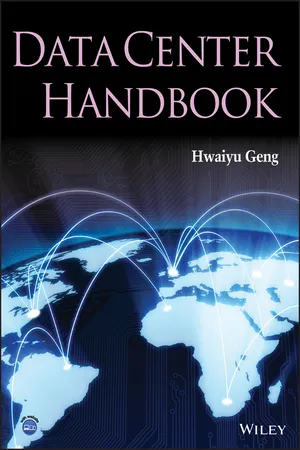
Data Center Handbook
Hwaiyu Geng
- English
- ePUB (mobile friendly)
- Available on iOS & Android
Data Center Handbook
Hwaiyu Geng
About This Book
Provides the fundamentals, technologies, and best practices in designing, constructing and managing mission critical, energy efficient data centers
Organizations in need of high-speed connectivity and nonstop systems operations depend upon data centers for a range of deployment solutions. A data center is a facility used to house computer systems and associated components, such as telecommunications and storage systems. It generally includes multiple power sources, redundant data communications connections, environmental controls (e.g., air conditioning, fire suppression) and security devices.
With contributions from an international list of experts, The Data Center Handbook instructs readers to:
- Prepare strategic plan that includes location plan, site selection, roadmap and capacity planning
- Design and build "green" data centers, with mission critical and energy-efficient infrastructure
- Apply best practices to reduce energy consumption and carbon emissions
- Apply IT technologies such as cloud and virtualization
- Manage data centers in order to sustain operations with minimum costs
- Prepare and practice disaster reovery and business continuity plan
The book imparts essential knowledge needed to implement data center design and construction, apply IT technologies, and continually improve data center operations.
Frequently asked questions
Information
Part I
Data Center Overview and Strategic Planning
1
Data Centers—Strategic Planning, Design, Construction, and Operations
1.1 Introduction
1.1.1 Data Centers and Global Warming
1.1.2 Data Center Definition
- “Primarily electronic equipment used for data processing (servers), data storage (storage equipment), and communications (network equipment). Collectively, this equipment processes, stores, and transmits digital information.”
- “Specialized power conversion and backup equipment to maintain reliable, high-quality power, as well as environmental control equipment to maintain the proper temperature and humidity for the ICT equipment.”
| Facility types | Volume servers | Estimated servers per facility | Typical size in sq. ft. (m2) | Estimated number of facilities (in the United States) | 2006 electric use (billion kWh) |
| Server closets | 1,798,000 | 1–2 | <200 (19) | 900,000–1,500,000 | 3.5 |
| Server rooms | 2,120,000 | 3–36 | <500 (46) | 50,000–100,000 | 4.3 |
| Localized data center | 1,820,000 | 36–300 | <1000 (93) | 10,000–13,000 | 4.2 |
| Midtier data center | 1,643,000 | 300–800 | <5000 (465) | 2,000–4,000 | 3.7 |
| Enterprise-class data center | 3,215,000 | 800–2000+ | 5000+ (465+) | 1,000–2,500 | 8.8 |
1.1.3 Energy Consumption Trends
Table of contents
- Cover
- Title page
- Copyright page
- Dedication page
- Contributors
- Preface
- Acknowledgments
- Technical Advisory Board
- Chapter Organization
- About the Companion Website
- Part I: Data Center Overview and Strategic Planning
- Part II: Data Center Design and Construction
- Part III: Data Center Technology
- Part IV: Data Center Operations and Management
- Part V: Disaster Recovery and Business Continuity
- Index
- End User License Agreement